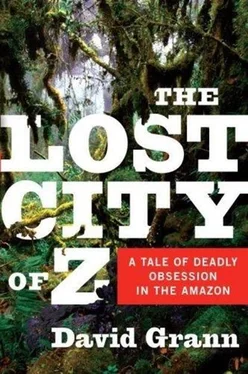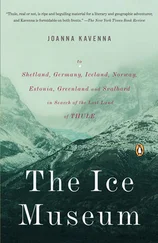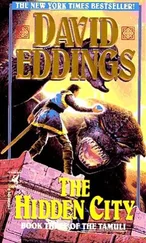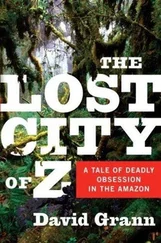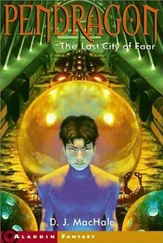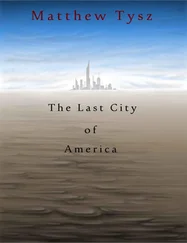But even if the Amazon could, as he supposed, sustain a large civilization, had the Indians ever actually constructed one? There was still no archaeological evidence. There was not even evidence of dense populations in the Amazon. And the notion of a complex civilization contradicted the two main ethnological paradigms that had prevailed for centuries and that originated with the first encounter between Europeans and Native Americans, more than four hundred years earlier. Though some of the first conquistadores were in awe of the civilizations that Native Americans had developed, many theologians debated whether these dark-skinned, scantily clad peoples were, in fact, human; for how could the descendants of Adam and Eve have wandered so far, and how could the biblical prophets have been ignorant of them? In the mid-sixteenth century, Juan Ginés de Sepúlveda, one of the Holy Roman Emperor's chaplains, argued that the Indians were “half men” who should be treated as natural slaves. “The Spanish have a perfect right to rule these barbarians of the New World,” Sepúlveda declared, adding, “For there exists between the two as great a difference as between… apes and men.”
At the time, the most forceful critic of this genocidal paradigm was Bartolomé de Las Casas, a Dominican friar who had traveled throughout the Americas. In a famous debate with Sepúlveda and in a series of treatises, Las Casas tried to prove, once and for all, that Indians were equal humans (“Are these not men? Do they not have rational souls?”), and to condemn those “pretending to be Christians” who “wiped them from the face of the earth.” In the process, however, he contributed to a conception of the Indians that became an equal staple of European ethnology: the “noble savage.” According to Las Casas, the Indians were “the simplest people in the world,” “without malice or guile,” “never quarrelsome or belligerent or boisterous,” who “are neither ambitious nor greedy, and are totally uninterested in worldly power.”
Although in Fawcett's era both conceptions remained prevalent in scholarly and popular literature, they were now filtered through a radical new scientific theory: evolution. Darwin's theory, laid out in On the Origin of Species in 1859, suggested that people and apes shared a common ancestor, and, coupled with recent discoveries of fossils revealing that humans had been on earth far longer than the Bible stated, helped irrevocably to sever anthropology from theology. Victorians now attempted to make sense of human diversity not in theological terms but in biological ones. The manual Notes and Queries on Anthropology, which was recommended reading in Fawcett's exploring school, included chapters titled “Anatomy and Physiology,” “Hair,” “Colour,” “Odour,” “Motions,” “Physiognomy,” “Pathology,” “Abnormalities,” “Reproduction,” “Physical Powers,” “Senses,” and “Heredity.” Among the questions that Fawcett and other explorers were told to answer were:
Is there any notable peculiarity of odour attached to the persons of the tribe or people described? What is the habitual posture in sleep? Is the body well balanced in walking? Is the body erect and the leg straightened? Or do they stand and move with the knee slightly bent? Do they swing the arm in walking? Do they climb trees well? Is astonishment expressed by the eyes and mouth being opened wide, and by the eyebrows being raised? Does shame excite a blush?
The Victorians wanted to know, in effect, why some apes had evolved into English gentlemen and why some hadn't.
Whereas Sepúlveda had argued that Indians were inferior on religious grounds, many Victorians now claimed that they were inferior on biological ones-that they were possibly even a “missing link” in the evolutionary chain between apes and men. In 1863, the Anthropological Society of London was created to investigate such theories. Richard Burton, one of the Society's founders, postulated that Indians, like blacks, with their “ quasigorillahood,” belonged to a “ sub-species.” (Darwin himself, who never subscribed to the extreme racialism that emerged in his name, described the Fuegians he saw in South America-“these poor wretches… stunted in their growth, their hideous faces bedaubed with white paint, their skins filthy and greasy, their hair entangled, their voices discordant, and their gestures violent and without dignity”-as if it were hard to “believe they are fellow-creatures, and inhabitants of the same world.”) Many anthropologists, including Burton, practiced phrenology-the study of the protuberances on human skulls, which were thought to indicate intelligence and character traits. One phrenologist comparing two Indian craniums with those of Europeans said that the former were marked by “firmness” and “secretiveness” and that their shape explained “the magnanimity displayed by the Indians in their endurance of torture.” Francis Galton, in his theory of eugenics, which once counted among its followers John Maynard Keynes and Winston Churchill, argued that human intelligence was inherited and immutable and that native peoples of the New World were intrinsically “children in mind.” Even many Victorians who believed in a “psychic unity to mankind” assumed that Indian societies were in a different stage of evolutionary development. By the early twentieth century, the then-popular diffusionist school of anthropologists maintained that if a sophisticated ancient civilization ever did exist in South America, its origins were either Western or Near Eastern-in the lost tribes of Israel, for example, or in seafaring Phoenicians. “There are all sorts of theories among anthropologists regarding the distribution of the human race,” Keltie, of the Royal Geographical Society, noted, adding that diffusionist anthropologists “maintain that the Phoenicians navigated the whole of the Pacific Ocean, and that many of them penetrated South America.”
Fawcett was deeply influenced by such ideas-his writings are rife with images of Indians as “jolly children” and “ ape-like” savages. When he first saw an Indian cry, he expressed befuddlement, sure that physiologically Indians had to be stoic. He struggled to reconcile what he observed with everything he had been taught, and his conclusions were filled with convolutions and contradictions. He believed, for instance, that the jungle contained “savages of the most barbarous kind, ape-men who live in holes in the ground and come out only at night;” yet he nearly always described the Indians whom he met as being “civilized,” and often far more so than Europeans. (“My experience is that few of these savages are naturally ‘bad,' unless contact with ‘savages' from the outside world has made them so.”) He vigorously opposed the destruction of indigenous cultures through colonization. In the jungle, the absolutist became a relativist. After he witnessed a tribe cannibalize one of its dead as part of a religious ceremony-the body “roasted over a big fire” and “cut up and divided amongst the various families”-Fawcett beseeched Europeans not to deplore the “elaborate ritual.” He hated to classify unacculturated Indians as “savages”-then the common terminology-and he noted that the kind, decent Echojas were “plain proof of how unjustified is the general condemnation of all the wild forest people.” Along with adopting Indian mores, he learned to speak myriad indigenous languages. “He knew the Indians as few white men have ever known them, and he had the gift of tongues,” observed the adventure writer and Fawcett associate Thomas Charles Bridges. “Few men have ever possessed that gift to such a marked degree.” Costin, summing up Fawcett's relationship with the natives of the Amazon, said simply, “He understood them better than anyone.”
Читать дальше
Конец ознакомительного отрывка
Купить книгу
